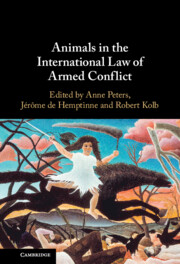Book contents
- Animals in the International Law of Armed Conflict
- Animals in the International Law of Armed Conflict
- Copyright page
- Contents
- Contributors
- Forewords
- Acknowledgements
- Abbreviations
- Part I The Need for Protecting Animals in Wartime
- Part II The Protection of Animals in International and Non-international Armed Conflicts
- 5 Animals as Property and as Objects
- 6 Animals as Specially Protected Objects
- 7 Animals as Part of the Environment
- 8 Animals as Endangered Species
- 9 Animals as War Weapons
- 10 Animals as Combatants and as Prisoners of War?
- 11 Animals as Means of Medical Transportation, Search and Rescue
- 12 Veterinary Personnel
- Part III The Protection of Animals in Specific Situations
- Part IV Enforcement Regimes for the Protection of Animals in Wartime
- Part V Towards Better Protection of Animals in Wartime
- Index
- References
7 - Animals as Part of the Environment
from Part II - The Protection of Animals in International and Non-international Armed Conflicts
Published online by Cambridge University Press: 06 October 2022
- Animals in the International Law of Armed Conflict
- Animals in the International Law of Armed Conflict
- Copyright page
- Contents
- Contributors
- Forewords
- Acknowledgements
- Abbreviations
- Part I The Need for Protecting Animals in Wartime
- Part II The Protection of Animals in International and Non-international Armed Conflicts
- 5 Animals as Property and as Objects
- 6 Animals as Specially Protected Objects
- 7 Animals as Part of the Environment
- 8 Animals as Endangered Species
- 9 Animals as War Weapons
- 10 Animals as Combatants and as Prisoners of War?
- 11 Animals as Means of Medical Transportation, Search and Rescue
- 12 Veterinary Personnel
- Part III The Protection of Animals in Specific Situations
- Part IV Enforcement Regimes for the Protection of Animals in Wartime
- Part V Towards Better Protection of Animals in Wartime
- Index
- References
Summary
This chapter argues that animals, as part of the environment, benefit from the protection afforded by the direct and indirect environmental safeguards offered by principles and rules of international humanitarian law. However, it also reveals that the pertinent norms are weak and largely unclear, especially in the context of non-international armed conflicts. For this reason, the chapter contends that the said rules need to be read in conjunction with the growing body of international norms, standards and mechanisms that seek to prevent and redress environmental harm during peacetime. Indeed, international environmental law has the potential to protect animals from suffering from the general deterioration of natural habitats and ecosystems caused by humans. However, the protection offered by the relevant instruments and unwritten principles is severely constrained by their narrow substantive, personal and territorial scope of application.
Keywords
- Type
- Chapter
- Information
- Animals in the International Law of Armed Conflict , pp. 109 - 128Publisher: Cambridge University PressPrint publication year: 2022
References
Select Bibliography
- 1
- Cited by

